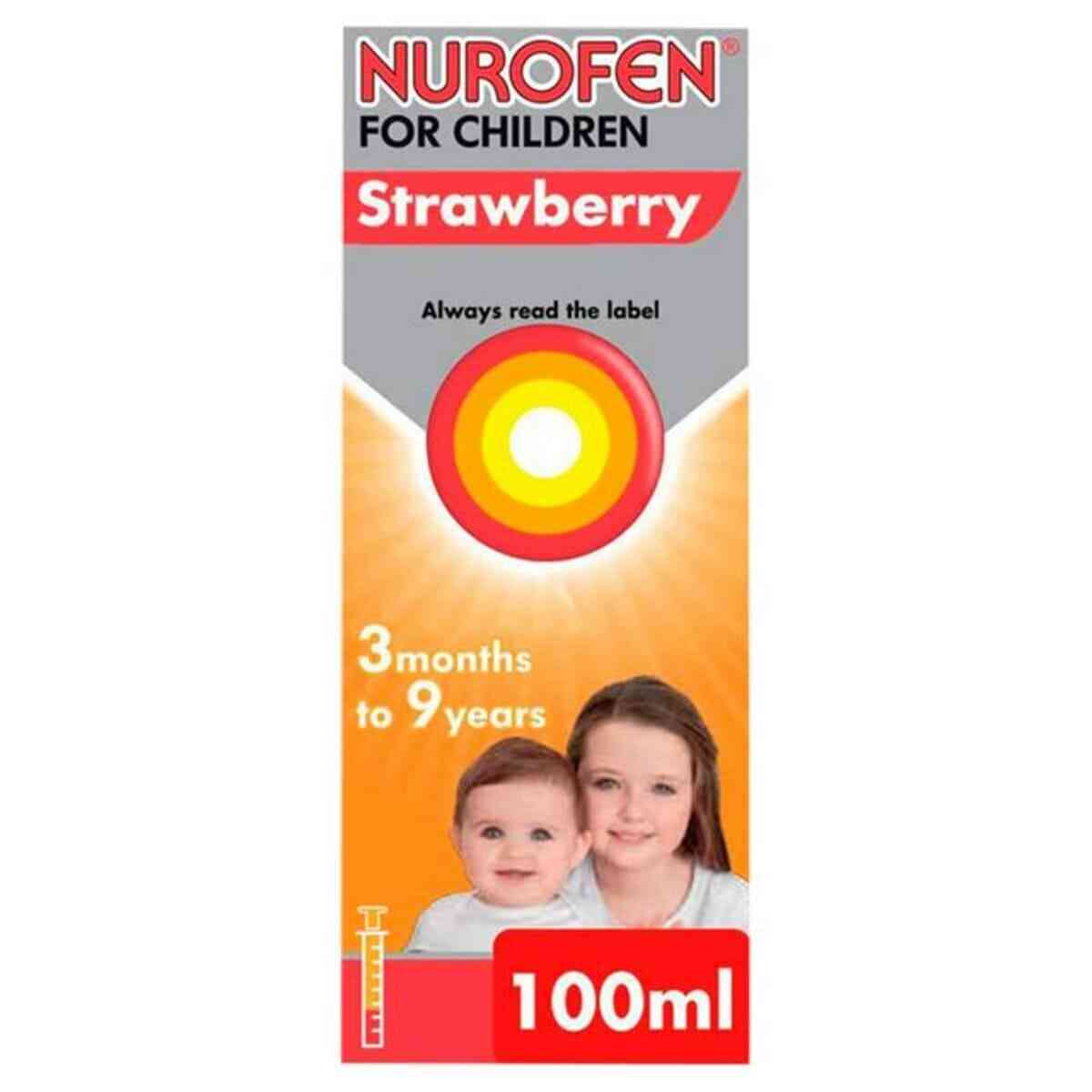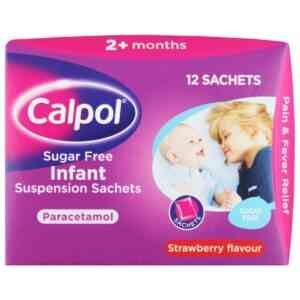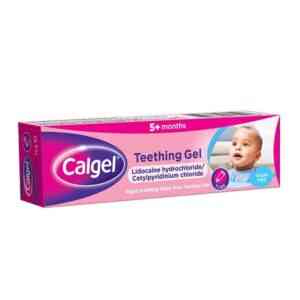Description
Nurofen For Children Strawberry Ibuprofen, 100ml
What is Nurofen For Children Strawberry Ibuprofen Oral Suspension?
Nurofen For Children Strawberry Ibuprofen oral suspension, the active ingredient (which makes this medicine work) is
ibuprofen which is a non-steroidal anti-inflammatory (NSAID) painkiller. Ibuprofen is used as an analgesic (painkiller) for the relief of symptoms of cold and flu and mild to moderate pain, such as a sore throat, teething pain, toothache, earache, headache, minor aches, and sprains. This medicine also brings down a high temperature (fever) including fever caused by immunisation.
What is it for
Nurofen for Children Strawberry 3mths-9yrs 100ml is a liquid ibuprofen suspension that provides pain and fever relief for babies from 3 months and weighing over 5kg. It starts providing fever relief in 15 minutes and lasts for up to 8 hours.
Nurofen for Children provides longer-lasting fever relief than paracetamol.
It is available in both Strawberry and Orange flavours.
For over 30 years, Nurofen has helped to provide millions of people with pain relief. We are experienced in Children’s fever & pain relief, and we are here to help.
Who can use it
Suitable for babies from 3 months and weighing over 5 kg to children 9 years
Benefits:
Up to 8 hours fever relief
Starts to get to work in 15 minutes to relieve fever
Free from artificial colours and flavours
Non-drip syringe for accurate and easy dosing
Free from artificial colours and flavours
Children friendly ibuprofen formula to relieve muscular pain, headache, dental pain, fever and the symptoms of cold and flu.
For short term use only. Do not give to babies aged 3 to 6 months for longer than 24 hours or children aged 6 months and over for longer than 3 days.
Pain in Babies & Children
As your little one is growing up, there are many things which can cause them pain or discomfort. This can range from teething pain, to minor injuries from bumps or knocks.
Common types of pains in children
When little ones are growing they can experience a variety of aches and pains. Toddlers and children can easily acquire minor injuries from bumps and knocks while playing or learning to walk. But they may also experience general aches and pains in their legs, head and ears.
Below we discuss growing pains and headaches. For information on pain associated with sore throats, coughs, and colds, visit our information pages on these ailments.
Growing Pains
While harmless, growing pains (mainly in the leg) in children can cause them discomfort. Growing pain is common in young children and pain is usually felt mainly in the leg muscles, not the joint, and gets worse in the evening or night-time. But the actual cause of growing pains isn’t clear. They can come on after lots of exercise. They usually appear in more active children aged three to four years old and can continue into the early teens. Growing pains in children can come and go and might last months, or years.
You can take comfort that growing pains usually aren’t an indication of anything serious, however.
Headaches
Headaches in children can be different to adult headaches. The most common headache disorders are migraine and tension type headaches. Regular headaches that affect the whole head and come with vomiting or stomach pain could be an indication of a migraine in a child.
Tension headaches in children usually last around 30 minutes.
High Temperature in Children
A high temperature is very common in young children. The temperature usually returns to normal within 3 or 4 days.
A normal temperature in babies and children is about 36.4C, but this can vary slightly from child to child.
A high temperature is 38C or more.
A high temperature is the body’s natural response to fighting infections like coughs and colds.
Many things can cause a high temperature in children, from common childhood illnesses like chickenpox and tonsillitis, to vaccinations.
Your child might:
- feel hotter than usual when you touch their back or chest
- feel sweaty
- look or feel unwell
Use a digital thermometer, which you can buy from pharmacies and supermarkets, to take your child’s temperature.
You can usually look after your child or baby at home. The temperature should go down over 3 or 4 days.
DO
-
give them plenty of fluids
-
look out for signs of dehydration
-
give them food if they want it
-
check on your child regularly during the night
-
keep them at home
-
give them paracetamol if they’re distressed or unwell
-
get medical advice if you’re worried about your child
DON’T
-
do not undress your child or sponge them down to cool them, a high temperature is a natural and healthy response to infection
-
do not cover them up in too many clothes or bedclothes
-
do not give aspirin to children under 16 years of age
-
do not combine ibuprofen and paracetamol, unless a GP tells you to
-
do not give paracetamol to a child under 2 months
-
do not give ibuprofen to a child under 3 months or under 5kg
-
do not give ibuprofen to children with asthma
CALL 111 OR YOUR GP SURGERY NOW IF YOUR CHILD:
- is under 3 months old and has a temperature of 38C or higher, or you think they have a high temperature
- is 3 to 6 months old and has a temperature of 39C or higher, or you think they have a high temperature
- has other signs of illness, such as a rash, as well as a high temperature
- has a high temperature that’s lasted for 5 days or more
- does not want to eat, or is not their usual self and you’re worried
- has a high temperature that does not come down with paracetamol
- is dehydrated – such as nappies that are not very wet, sunken eyes, and no tears when they’re crying
CALL 999 IF YOUR CHILD:
- has a stiff neck
- has a rash that does not fade when you press a glass against it (use the “glass test” from Meningitis Now)
- is bothered by light
- has a fit (febrile seizure) for the first time (they cannot stop shaking)
- has unusually cold hands and feet
- has blue, pale or blotchy skin, lips or tongue
- has a weak, high-pitched cry that’s not like their normal cry
- is drowsy and hard to wake
- is extremely agitated (does not stop crying) or is confused
- finds it hard to breathe and sucks their stomach in under their ribs
- is not responding like they normally do, or is not interested in feeding or normal activities
Nurofen For Children Strawberry Reviews
After using Nurofen For Children Strawberry, it’s helpful to let others know about your experience. Reviews of an item help other users know that medicines received have helped the condition it is claimed for, how well the treatment worked or any issues to be aware of. We invite our users to leave a review of both their treatment and of the service provided. Click on the reviews tab to see if there has been feedback on this item.
Price of Nurofen For Children Strawberry in UK
Buy Nurofen For Children Strawberry at Dock Pharmacy Essex UK, UK Online Pharmacy.
Does Nurofen For Children Strawberry contain paracetamol?
Nurofen For Children Strawberry contains ibuprofen – it does not contain paracetamol.
Nurofen For Children Strawberry and Calpol
Nurofen For Children Strawberry contains ibuprofen – Calpol contains paracetamol.
You should speak to your doctor before you give both products
 +44 (0) 1375 846 316
+44 (0) 1375 846 316




Reviews
There are no reviews yet